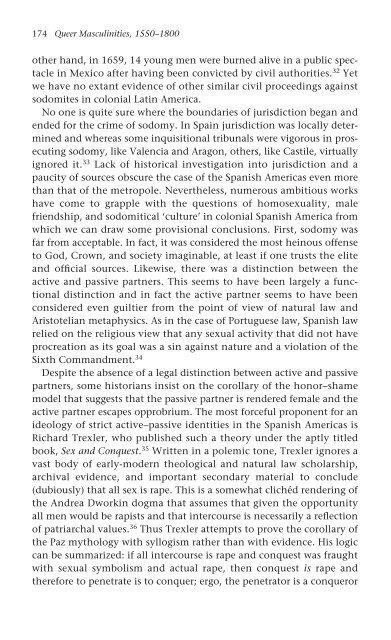queer masculinities
queer masculinities
queer masculinities
Create successful ePaper yourself
Turn your PDF publications into a flip-book with our unique Google optimized e-Paper software.
174 Queer Masculinities, 1550–1800<br />
other hand, in 1659, 14 young men were burned alive in a public spectacle<br />
in Mexico after having been convicted by civil authorities. 32 Yet<br />
we have no extant evidence of other similar civil proceedings against<br />
sodomites in colonial Latin America.<br />
No one is quite sure where the boundaries of jurisdiction began and<br />
ended for the crime of sodomy. In Spain jurisdiction was locally determined<br />
and whereas some inquisitional tribunals were vigorous in prosecuting<br />
sodomy, like Valencia and Aragon, others, like Castile, virtually<br />
ignored it. 33 Lack of historical investigation into jurisdiction and a<br />
paucity of sources obscure the case of the Spanish Americas even more<br />
than that of the metropole. Nevertheless, numerous ambitious works<br />
have come to grapple with the questions of homosexuality, male<br />
friendship, and sodomitical ‘culture’ in colonial Spanish America from<br />
which we can draw some provisional conclusions. First, sodomy was<br />
far from acceptable. In fact, it was considered the most heinous offense<br />
to God, Crown, and society imaginable, at least if one trusts the elite<br />
and official sources. Likewise, there was a distinction between the<br />
active and passive partners. This seems to have been largely a functional<br />
distinction and in fact the active partner seems to have been<br />
considered even guiltier from the point of view of natural law and<br />
Aristotelian metaphysics. As in the case of Portuguese law, Spanish law<br />
relied on the religious view that any sexual activity that did not have<br />
procreation as its goal was a sin against nature and a violation of the<br />
Sixth Commandment. 34<br />
Despite the absence of a legal distinction between active and passive<br />
partners, some historians insist on the corollary of the honor–shame<br />
model that suggests that the passive partner is rendered female and the<br />
active partner escapes opprobrium. The most forceful proponent for an<br />
ideology of strict active–passive identities in the Spanish Americas is<br />
Richard Trexler, who published such a theory under the aptly titled<br />
book, Sex and Conquest. 35 Written in a polemic tone, Trexler ignores a<br />
vast body of early-modern theological and natural law scholarship,<br />
archival evidence, and important secondary material to conclude<br />
(dubiously) that all sex is rape. This is a somewhat clichéd rendering of<br />
the Andrea Dworkin dogma that assumes that given the opportunity<br />
all men would be rapists and that intercourse is necessarily a reflection<br />
of patriarchal values. 36 Thus Trexler attempts to prove the corollary of<br />
the Paz mythology with syllogism rather than with evidence. His logic<br />
can be summarized: if all intercourse is rape and conquest was fraught<br />
with sexual symbolism and actual rape, then conquest is rape and<br />
therefore to penetrate is to conquer; ergo, the penetrator is a conqueror


